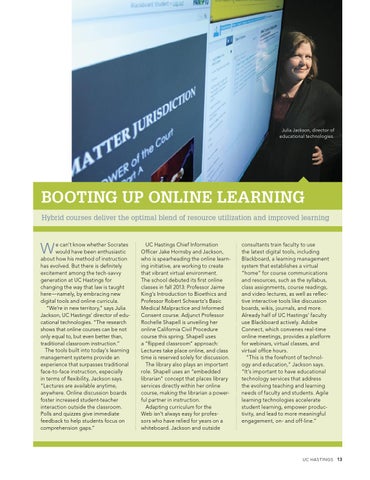Julia Jackson, director of educational technologies.
BOOTING UP ONLINE LEARNING Hybrid courses deliver the optimal blend of resource utilization and improved learning
W
e can’t know whether Socrates would have been enthusiastic about how his method of instruction has evolved. But there is definitely excitement among the tech-savvy generation at UC Hastings for changing the way that law is taught here—namely, by embracing new digital tools and online curricula. “We’re in new territory,” says Julia Jackson, UC Hastings’ director of educational technologies. “The research shows that online courses can be not only equal to, but even better than, traditional classroom instruction.” The tools built into today’s learning management systems provide an experience that surpasses traditional face-to-face instruction, especially in terms of flexibility, Jackson says. “Lectures are available anytime, anywhere. Online discussion boards foster increased student-teacher interaction outside the classroom. Polls and quizzes give immediate feedback to help students focus on comprehension gaps.”
UC Hastings Chief Information Officer Jake Hornsby and Jackson, who is spearheading the online learning initiative, are working to create that vibrant virtual environment. The school debuted its first online classes in fall 2013: Professor Jaime King’s Introduction to Bioethics and Professor Robert Schwartz’s Basic Medical Malpractice and Informed Consent course. Adjunct Professor Rochelle Shapell is unveiling her online California Civil Procedure course this spring. Shapell uses a “flipped classroom” approach: Lectures take place online, and class time is reserved solely for discussion. The library also plays an important role. Shapell uses an “embedded librarian” concept that places library services directly within her online course, making the librarian a powerful partner in instruction. Adapting curriculum for the Web isn’t always easy for professors who have relied for years on a whiteboard. Jackson and outside
consultants train faculty to use the latest digital tools, including Blackboard, a learning management system that establishes a virtual “home” for course communications and resources, such as the syllabus, class assignments, course readings, and video lectures, as well as reflective interactive tools like discussion boards, wikis, journals, and more. Already half of UC Hastings’ faculty use Blackboard actively. Adobe Connect, which convenes real-time online meetings, provides a platform for webinars, virtual classes, and virtual office hours. “This is the forefront of technology and education,” Jackson says. “It’s important to have educational technology services that address the evolving teaching and learning needs of faculty and students. Agile learning technologies accelerate student learning, empower productivity, and lead to more meaningful engagement, on- and off-line.”
UC HASTINGS 13
